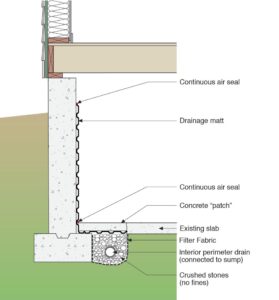Interior Foundation and Basement Retrofits
How to fix a leaky basement without digging a hole, adding an exterior drain, or re-landscaping
One of the most difficult issues to deal with as a landlord or a homeowner is a leaking foundation or basement wall. You go through a whole bunch of stages, much like grief counseling. First is denial that it is a real problem, and then anger that you now have to address it. Then bargaining follows. Use a waterproof paint on the inside; that will make it go away. Add gutters and downspouts and change the grade; that will make it go away. Epoxy injection, that’s the ticket; that will make it go away. How about penetrating magic waterproofing agents to give the concrete arterial sclerosis—plugging up those capillaries—that will make it go away. Of course, with real leakage, none of this works and depression follows. Yup, going to have to do it the hard, expensive—but, ultimately, the best—way: dig up the outside, add an exterior perimeter drain, an exterior full-height drainage or dampproofing layer. Then backfill, re-landscape, and adjust the mortgage. You begin to realize you have to accept your fate… Or do you?
Is there some approach short of exterior excavation and retrofitting a traditional waterproofing system? Yes. Install an interior drainage system. You don’t have to dig up the exterior and re-landscape. Install an interior perimeter drain and couple it with a full-height water proofing layer – a drainage mat. This drainage mat needs to be vapor tight and air tight to control the entry of water vapor and soil gases.

Interior drainage? Isn’t that against all the rules? Actually, no. We do interior drainage all the time in large-scale construction projects such as tunnels through the Alps and deep foundations on commercial buildings. I need to clarify here. We don’t always do interior drainage on tunnels when we are not very smart, such as the Big Dig in Boston, which has turned out to be the longest water ride in the world. Ah, my hometown of Boston. Don’t worry – the Big Dig is getting slowly fixed with yes, wait for it, interior drainage.

The key to interior drainage if you are a homeowner with a leaking foundation or basement wall is to direct the water “to somewhere.” The only real choice is a sump pit with a pump. The pump should have a battery back-up and it should have an airtight lid. The battery back-up is obvious. Power goes out when it is raining hard and you need the drainage the most. The airtight lid is not so obvious. If the lid on the sump pit is not airtight, soil gases such as radon, pesticides, termiticides, and herbicides enter. Notice the “cides” part. The “cide” ending, such as in homicide, comes from the Latin “caedere,” meaning “kill”. And if radon was valuable, we would mine it with a sump pit. Go with the airtight lid on the sump pit.
Direct the water that penetrates the foundation wall downwards to an interior perimeter drain and connect the interior perimeter drain to an airtight sump pit with a pump and battery back-up. Here is another big deal point. Do not, I repeat, do not connect the interior perimeter drain and sump pit to the neighborhood storm drain system. Huh? Yup, they are not designed very well and back up all the time, flooding the very basements they were intended to protect.
Let’s now look at the interior drainage mat. Recall how important it is to make sure the sump pit is airtight? Same thing for the interior drainage mat, and the interior perimeter drain it is connected to. The drainage mat should be a solid material that is airtight and vapor tight that also provides control of hydrostatic pressure. Controlling hydrostatic pressure is the easy part – provide an airspace between the foundation wall and the interior surface of the drainage mat that allows the water to run down to the interior perimeter drain. The air control and vapor control are more difficult. The interior drainage mat needs to be both an air barrier and a vapor barrier. It needs to be sealed air tight at the top of the wall. It needs to be sealed at the bottom of the wall. It needs to be sealed at its vertical joints. Note that the top of the wall means “above grade.”
 Pretty neat, eh? Install an interior drainage mat just as you would an exterior drainage mat. Both interior and exterior approaches need to control hydrostatic pressure and both need to be connected to a perimeter drain that is connected to a sump pit with an airtight lid. The big difference between the two approaches is that the interior approach absolutely needs to be air tight and vapor tight. Let me repeat, the interior approach absolutely needs to be air tight and vapor tight.
Pretty neat, eh? Install an interior drainage mat just as you would an exterior drainage mat. Both interior and exterior approaches need to control hydrostatic pressure and both need to be connected to a perimeter drain that is connected to a sump pit with an airtight lid. The big difference between the two approaches is that the interior approach absolutely needs to be air tight and vapor tight. Let me repeat, the interior approach absolutely needs to be air tight and vapor tight.
How about finishing the interior after you are done? Knock yourself out. You can pretty much do anything… except for one stipulation. Absolutely, positively do not penetrate the interior drainage mat.
If you’re looking for a drainage mat recommendation, look no further than the DELTA®-MS foundation protection system. It’s impermeable to water, and keeps ground moisture away from foundation walls. What if water does get in? The dimple pattern in the mat creates an air gap between the membrane and the foundation, allowing any incidental water to flow into the perimeter footing drain. More details on DELTA®-MS here.
 About Joe Lstiburek, Ph.D., P.Eng., ASHRAE Fellow, Principal, Building Science Corporation:
About Joe Lstiburek, Ph.D., P.Eng., ASHRAE Fellow, Principal, Building Science Corporation:
Joe Lstiburek is the founding principal of Building Science Corporation, one of the most influential, innovative, and respected building science firms in North America. Dr. Lstiburek’s work ranges widely, from providing expert witness testimony to overseeing research and development projects, to writing for the ASHRAE Journal. His commitment to advancing the building industry has had a lasting impact on building codes and practices throughout the world, particularly in the areas of air barriers, vapor barriers, and vented and unvented roof assemblies.
Dr. Lstiburek is also an acclaimed educator who has taught thousands of professionals over the past three decades and written countless papers as well as the best-selling Builder Guides. His commitment to education earned him the hailing, “the dean of North American building science” by the Wall Street Journal. You can find additional details on Dr. Lstiburek on our About the Blog page.
